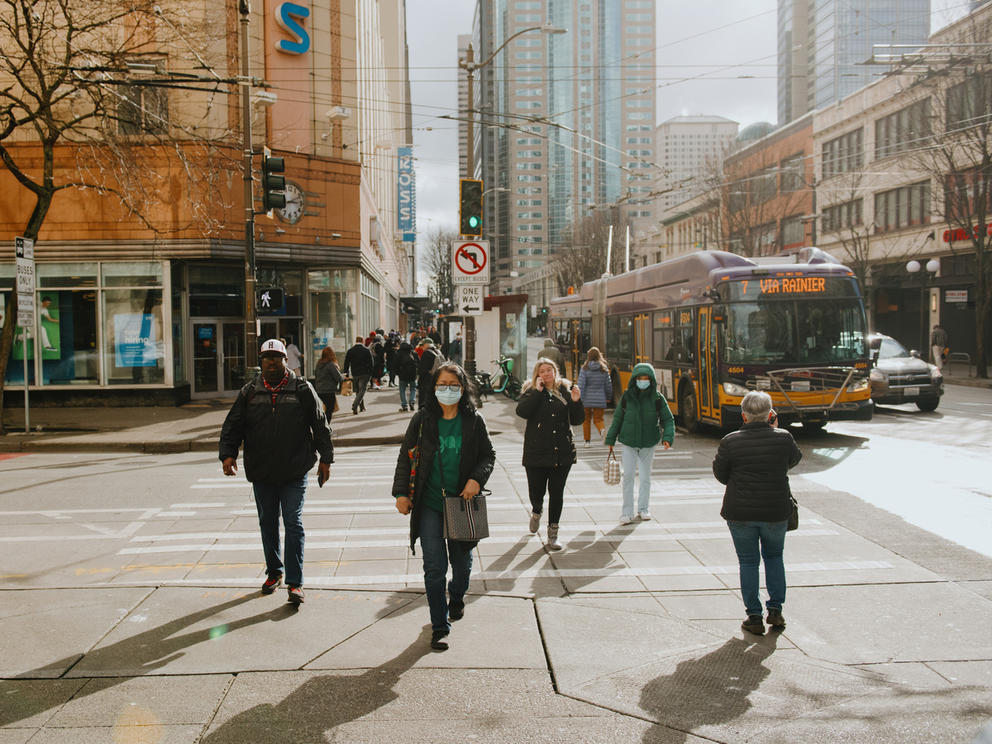The mayor hopes the investments will bring more people back to the city's greater Downtown area after the COVID-19 pandemic decimated the activity from daily office workers, visitors and tourists. According to the Downtown Seattle Association, in-person office work is back to about 48% of its pre-pandemic levels. At the height of summer last year, tourist visits were just shy of pre-pandemic numbers.
Harrell wants to build on this progress by making Downtown more attractive for both visitors and locals.
The Downtown Activation Plan is split into seven goal areas: public safety; residential occupancy; retail recovery; Downtown work; arts, culture and events; tourism and local visitors; and environmental efforts. It also includes a few bigger ideas, which Harrell calls “Space Needle thinking,” that the city is exploring, but isn’t committed to implementing.
City staff did not have an estimate of the cost of implementing each of the dozens of proposals. However, Office of Economic Development Director Markham McIntyre said, “One of our design constraints was to try to do [it] low-cost, within our budget. Everything you’re seeing here we believe we can do, not necessarily within this budget [cycle], but well within the city’s pocketbook.”
Public safety
To address public safety Downtown, the Seattle Police Department will continue targeting drug dealers and trying to reduce gun violence. The mayor intends to extend funding for the Third Avenue Project pilot through the end of 2023 and try to secure additional dollars during this fall’s budget cycle. The project involves concerted outreach efforts with people engaged in the drug economy and those experiencing homelessness around Third Avenue and Pike Street, a decades-long issue in Seattle.
The city also plans to establish an opioid recovery center that paramedics and social workers can take people to, similar to existing sobering centers, to reduce the strain on Harborview hospital. They are also launching a “contingency management” drug program that provides incentives for sobriety.
The plan includes other quality-of-life initiatives such as a one-time $1.7 million boost to the Downtown Seattle Association’s Metropolitan Improvement District program for cleaning; the hospitality and downtown ambassadors program; improved street lighting; and graffiti cleanup.
Downtown living
To replace some of the lost in-person office workers who’ve switched to hybrid work, the city wants to increase the number of residents living Downtown. In service of that goal, the mayor’s plan includes upzoning Third Avenue from Union Street to Virginia Street to allow taller residential buildings and to waive state environmental review requirements for residential construction Downtown. The new maximum building height would be 440 feet, up from the current 170 feet, or about 17 floors.
The mayor also has proposed creating a density bonus on Third and Fourth Avenues in the Downtown core for residential developers who include a child care or educational facility in ground-level space. Tim Burgess, the mayor’s director of strategic innovations, said this could help provide Seattle Public Schools with space to build a Downtown school someday.
The city also wants to pass regulatory changes to make it less expensive for developers to convert office buildings into residential spaces.
In addition to upzones, the plan includes bringing more farmers markets Downtown, encouraging more grocery stores to open, improving alleyways for pedestrian use and more.
Retail
In June, Harrell launched The Liberty Project to support Black and other business owners from underserved communities with their small businesses. As part of the Downtown plan, the Office of Economic Development will support those business owners in opening or maintaining Downtown businesses.
The mayor also wants to expand the Seattle Restored program which places pop-up businesses and art galleries in vacant retail spaces.
Downtown work
Although a portion of the plan is dedicated to repurposing vacant office space, the mayor still wants people back in the office. He plans to bring together public- and private-sector business leaders to encourage return-to-office policies as well as create “effective” hybrid work policies.
The plan is to have a series of networking events for Downtown workers such as June 28’s Black Tech Night.
Arts, culture and events
The mayor plans to create a new director-level position to lead on special events in the city as well as hire a “creative economy” manager.
The activation plan also includes $700,000 for new murals in the greater Downtown area.
The city wants to temporarily waive fees for street use fees for food trucks and small-to-medium street and sidewalk events. On July 26 at 6 p.m. the city will host a viewing party in Westlake Park for the USA vs. Netherlands Women’s World Cup match.
Tourism and visitors
To make Downtown a better place to visit, the mayor wants to install a network of digital navigation kiosks, open the proposed Tribal Interpretive Center in Waterfront Park, improve connections from Downtown to the waterfront, and modify the Seattle Tourism Improvement Area to provide more money for advertising and marketing.
Environmental improvements
The reactivation plan includes goals of improving existing Downtown parks, exploring the use of Pier 48 as a new open green space, and similar green efforts. The mayor also plans to keep half of Pike Street between First and Second Avenues closed to cars, to serve as a pedestrian-only space. The eastern half of the block between the alleyway and Second Avenue will remain open.
‘Space Needle thinking’
Finally, the reactivation plan includes several bigger-picture ideas for improving Downtown that the city is committed to exploring, but not necessarily implementing.
They include constructing the First Avenue streetcar to connect the existing streetcar lines and creating an arts and entertainment district along the route; building a year-round indoor/outdoor sports facility downtown; renovating Westlake Plaza with interactive art installations and year-round programming; building a new market dedicated to businesses run by Black, Indigenous and other people of color; and more.



